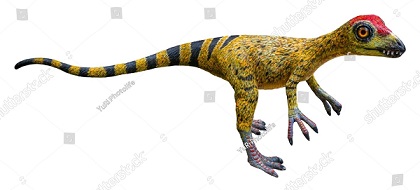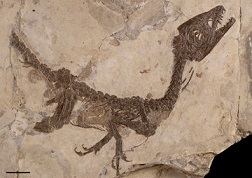
Scipionyx is a genus of small theropod Dinosaur that lived during the Early Cretaceous period, approximately 113 million years ago. What sets Scipionyx apart from many other dinosaur genera is its diminutive size and remarkably preserved fossils. In this exploration, we will delve into the classification, physical characteristics, habitat, behavior, and significance of Scipionyx in the world of paleontology.
Scipionyx belongs to the theropod group, a diverse group of bipedal carnivorous dinosaurs that includes well-known giants like Tyrannosaurus rex and Velociraptor. It is a member of the family Compsognathidae, characterized by their small size and gracile build.
The first fossils of Scipionyx were discovered in Italy in the early 1990s, specifically in the famous Crato Formation of Brazil, known for its exceptional preservation of fossils. These finds included an incredibly well-preserved specimen, providing an unprecedented look into the anatomy and biology of a small dinosaur.
| Name: | Scipionyx dinosaurs |
| Size: | Around 25 centimeters (10 inches) in length , 150 grams in weight. |
| Main Facts: | Scipionyx is a remarkable dinosaur with feathered fossils, shedding light on early feather evolution and potential avian connections among dinosaurs. |
Scipionyx lived during the Early Cretaceous, a time of diversification among dinosaurs. Its fossils have been found in Italy, suggesting a habitat that included both terrestrial and possibly aquatic environments.
The exceptional preservation of a Scipionyx specimen provided unique insights into its biology. This individual was found with preserved soft tissues, including muscles, blood vessels, and even the remains of its last meal, which was a lizard. Such remarkable preservation has allowed scientists to study the internal anatomy and likely behavior of this tiny dinosaur.

Scipionyx possessed several distinctive physical characteristics :
Scipionyx was a small dinosaur, with an estimated length of about 2.5 feet (0.75 meters) and a weight of around 2-3 pounds (1-1.5 kilograms).
Like many theropods, Scipionyx is believed to have had feathers covering its body. While direct evidence of feathers was not preserved, close relatives of Scipionyx are known to have had them.
It walked on two legs, a common feature among theropod dinosaurs.
Scipionyx holds significant importance in the field of paleontology for several reasons :
The well-preserved Scipionyx specimen offered an unprecedented opportunity to study the soft tissues and internal anatomy of a dinosaur, shedding light on its biology, digestion, and physiology.
Scipionyx highlights the fact that not all dinosaurs were massive giants. It showcases the incredible diversity of dinosaur sizes and adaptations.
As a member of the theropod group, Scipionyx contributes to our understanding of the evolution and biology of carnivorous dinosaurs.
Scipionyx is a small theropod dinosaur from the Early Cretaceous period, about 113 million years ago. It measured approximately 2.5 feet in length and had a feathered body, typical of theropods. Notable for its remarkably preserved fossils, Scipionyx provided insights into the internal anatomy and biology of small dinosaurs.
Fossils revealed soft tissues, including muscles and blood vessels, as well as the remains of its last meal, a lizard. This exceptional preservation allowed scientists to study its likely diet, behavior, and physiology, making Scipionyx a significant contributor to our understanding of these tiny yet fascinating dinosaurs.
Scipionyx is known for its bird-like characteristics, including feathers, which are exceptionally rare among dinosaur fossils. Comparing it to other dinosaurs emphasizes its potential role in the evolution of feathers and flight.
Scipionyx was a small dinosaur, with a body length of about 25 centimeters. This contrasts significantly with larger theropods like Tyrannosaurus rex, highlighting the broad size range among dinosaurs.
Scipionyx was a carnivore, likely preying on small vertebrates and insects. Comparing its diet to the herbivorous preferences of many other dinosaurs showcases the diverse feeding adaptations among these creatures.
Detailed analysis of Scipionyx's feathers offers insights into the structure and function of early feathers, supporting theories about their insulation and potentially limited flight capabilities.
Scipionyx lived during the Early Cretaceous period, while other well-known dinosaurs like Velociraptor and Brachiosaurus existed during different geological epochs, illustrating the temporal diversity of dinosaurs.
Scipionyx fossils were found in Italy. Contrasting this with discoveries in North America or Asia highlights the global distribution of dinosaurs during the Mesozoic era.
Scipionyx's feathers and its potential for limited flight have led scientists to consider its role in the evolution of flight. Contrasting this with non-avian dinosaurs underscores the gradual transition from ground-dwellers to avian ancestors.
Scipionyx's feathered fossil is essential in the study of feather evolution, contributing to our understanding of how feathers developed and diversified in dinosaur lineages, eventually leading to birds.